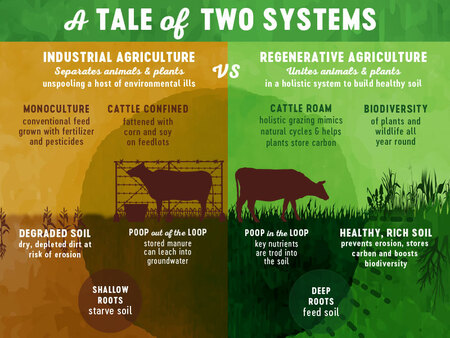Regenerative Agriculture 101
/filters:strip_icc()/filters:format(jpeg)/filters:background_color(fff)/filters:quality(60)/fit-in/1500x0/2022/03/08/21/22/13/eb9688dc-c1da-47b9-8f43-84238a64b5be/Blog-Image-1500x609.jpg)
By: Applegate
March 08, 2022
What is Regenerative Agriculture?
The term regenerative agriculture is believed to have been coined in the 1980s by Robert Rodale to describe a holistic system of farming that goes beyond sustainable and encourages continuous innovation and improvement.
More recently, the term was promoted and taken mainstream by Allan Savory, the founder of the Savory Institute, who created a system of holistic management that mimics the ways wild herds of animals move to rebuild soil.
Today, there is no one definition for regenerative agriculture, but there is widespread agreement on the type of practices used in regenerative farming.
Regenerative Agricultural Practices
Regenerative farming techniques are designed to improve soil health and increase the amount of arable topsoil. Common practices include:
Low- or No-till Farming
To stop the release of carbon dioxide.
Crop Rotation and Cover Cropping
To build and protect soil.
Increasing Crop Diversity
To feed the soil and help to build a diversity of microorganisms in the soil.
Animal Integration
When animals graze, they feed on plants, which release their carbon-rich roots into the soil. The animals also trample the ground, creating pockets for water to pool, and fertilize it with their excrement. This is why a popular slogan for regenerative farming is: Keep the poop in the loop!
Planned Holistic Grazing
Not all grazing is created equal. Regenerative grazing means managing where and for how long animals graze and adapting that plan to the evolving needs of the landscape.

Our Definition of Regenerative Agriculture
As a meat company, Applegate’s definition of regenerative agriculture focuses on positive animal impact. So, we are helping to build systems in which the animals’ grazing and movement across grasslands is managed with the goal to improve their health as well as that of the soil.
We are also committed to continuous progress. In other words, we don’t just set a standard and ask ranchers to meet it. We measure outcomes and help ranchers to continuously improve their land and their soil.
How Does This Work?
To measure outcomes, we partner with the Savory Institute, a pioneer in the practice and measurement of regenerative agriculture, and creator of the Land to Market seal, a first-of-its-kind verification that assesses and monitors the impacts of regenerative agricultural practices.
To start, Savory representatives visit a ranch and take baseline measurements of soil metrics. These include biodiversity, soil health and ecosystem functions such as the water and mineral cycles and energy flows.
After 12 months, Savory returns to see what progress has been made and to make recommendations about how to make more progress over time. Savory also looks at carbon sequestration—the soil’s ability to capture carbon underground—but only takes those measurements every five years since (as you can imagine) it’s not a fast process.
Why is Regenerative Agriculture Important?
The very concept of regenerative agriculture requires an essential mental shift from the way we currently think about farming. It’s not about extracting value from the land. Or even sustaining it—by which people mean leaving the earth in the same condition in which we found it. It’s about trying to improve the land, and taking steps to help make it more healthy, more fertile and, ultimately, more productive.
The goal, in short, is to create a positive impact from the ground up one small step at a time.
What is the Promise of Regenerative Agriculture?
The hope is that regenerative practices will help improve the land in various ways including:
- Minimizing erosion and improving water retention
- Reducing fertilizer use
- Boosting biodiversity
- Sequestering carbon in the soil
/filters:strip_icc()/filters:quality(60)/fit-in/800x0/2019/03/27/14/02/31/ea1a9dab-078e-44e2-928d-6d9e9b0446e8/applegate.png)
Applegate
Changing The Meat We Eat®: Natural & Organic - No antibiotics, growth hormones, artificial ingredients or chemical nitrites - Humanely Raised - Gluten Free